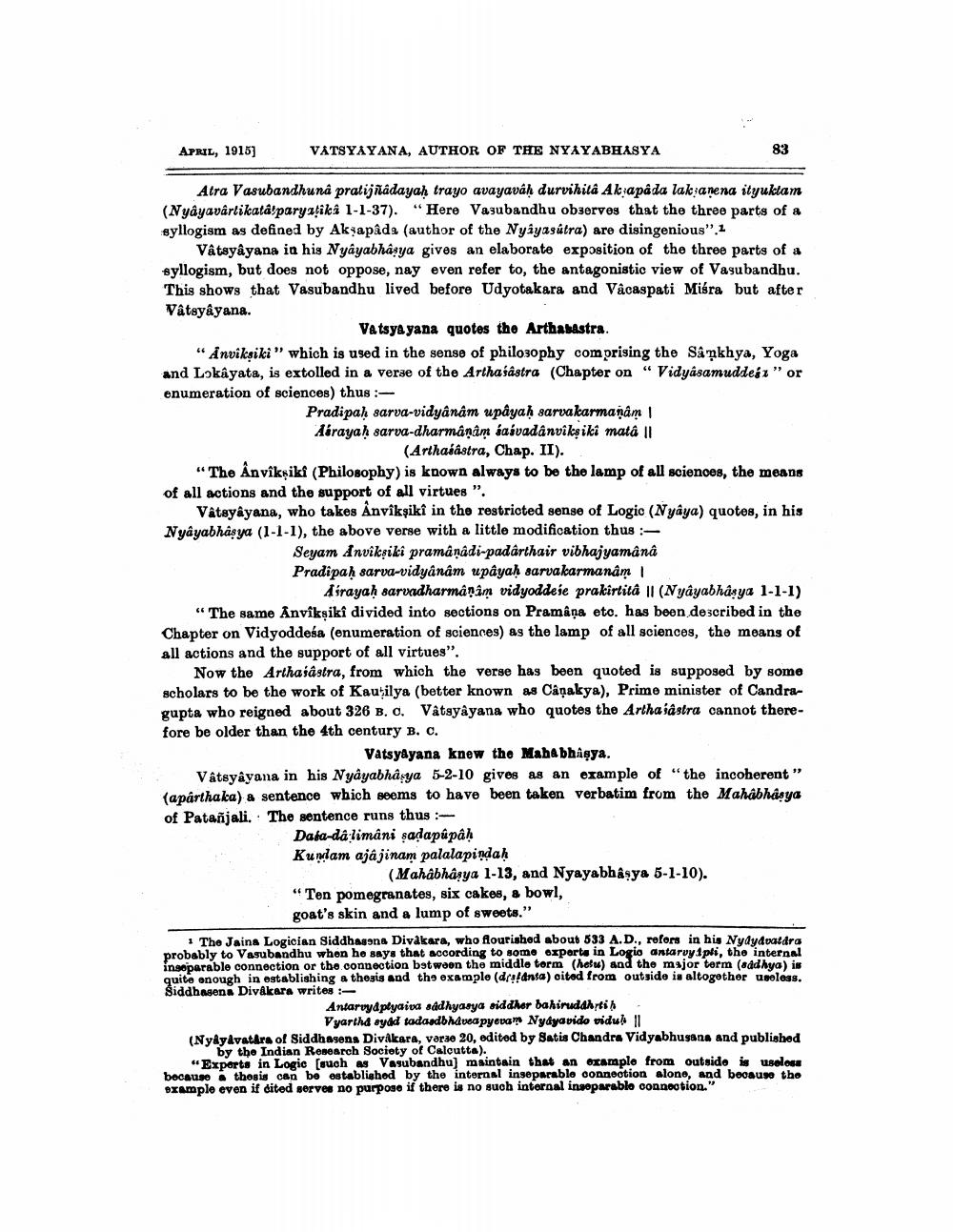________________
APRIL, 1915)
VATSYAYANA, AUTHOR OF THE NYAYABHASYA
83
Atra Vasubandhunâ pratijīâdayah trayo avayavah durvihita Akrapada lak anena ityuklam (Nyayavartikata paryaçika 1-1-37). "Here Vasubandhu observes that the three parts of a syllogism as defined by Ak apáda (author of the Nyiyasútra) are disingenious" 1
Vâtsyâyana ia his Nyâyabhâsya gives an elaborate exposition of the three parts of a syllogism, but does not oppose, nay even refer to the antagonistic view of Vasubandhu. This shows that Vasubandhu lived before Udyotakara and Vacaspati Misra but after Vâtsyâyana.
Vatsya yana quotes the Arthabastra. "Ånviksiki” which is used in the sense of philosophy comprising the Sámkhya, Yoga and L kâyata, is extolled in a verse of the Arthasastra (Chapter on “Vidyasamuddesi" or enumeration of sciences) thus :
Pradipah sarva-vidyanam upāyaḥ sarvakarmaņām! Abrayaḥ sarva-dharmanan kasvadânviks iki mata 11
(Arthasastra, Chap. II). “The Ânvikșiki (Philosophy) is known always to be the lamp of all sciences, the means of all actions and the support of all virtues ".
Vâtsyâyana, who takes Anvikşikî in the restricted sense of Logic (Nyaya) quotes, in his Nyayabhasya (1-1-1), the above verse with a little modification thus :
Seyam Anviksiki pramanadi-padárthair vibhajyamâna Pradipah sarva-vidyanam upayah sarvakarmanam
Lirayaḥ sarvadharmanin vidyoddeie prakirtitâ II (Nyayabhâsya 1-1-1) “The same Anviksiki divided into sections on Pramana eto, has been described in the Chapter on Vidyoddesa (enumeration of sciences) as the lamp of all sciences, the means of all actions and the support of all virtues".
Now the Arthajâstra, from which the verse has been quoted is supposed by some scholars to be the work of Kautilya (better known as Câmakya), Primo minister of Candragupta who reigned about 326 B. c. Vâtsyâyana who quotes the Artha sastra cannot therefore be older than the 4th century B. C.
Vatsyayana knew the Mahabhaşya. Vatsvavana in his Nyayabhâsya 5-2-10 gives as an example of "the incoherent " (a párthaka) a sentence which seems to have been taken verbatim from the Mahâbhâsya of Patañjali. The sentence runs thus
Daba-da-limani sadapúpah Kundam aja jinam palalapindah
(Mahâbhâsya 1-13, and Nyayabhâsya 5-1-10). "Ten pomegranates, six cakes, a bowl,
goat's skin and a lump of sweets." 1 The Jaina Logician Siddhasona Divakara, who flourished about 833 A.D., refors in his Nydydvatdra probably to Vasubandhu when he says that according to some experts in Logio antarvy ipli, the internal inseparable connection or the connection between the middle torm (
hu) and the major torm (addhya) is quite enough in establishing a thesis and the example (drs! Ansa) cited from outside is altogether useless. Siddhagens Divakara writes :
Antarvyd plyaiva sadhyasya siddhor bahiruddhrin
Vyarth sydd todasdbhdusa pyeva Nydya vido vidul 11 (Nyåyåvatars of Siddhagens Divákara, varje 20, edited by Satis Chandra Vidyabhusans and published
by the Indian Renoarch Society of Calcutta). "Experts in Logie (suohm Vasubandhu) maintain that an examplo from outsido is useless because thosis can be established by the internal inseparable connection alone, and because the DIAmplo even if dited serve no purpose if there is no such internal inseparablo connection."




